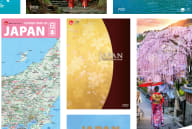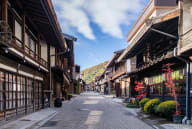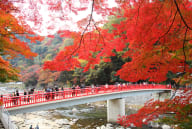
Toyama Nature’s pantry, crafted for your plate
A Culinary Journey in Toyama
Toyama Prefecture is a treasure trove of natural beauty and culinary delights. Bordered by the majestic Northern Alps and Toyama Bay, this picturesque prefecture enjoys a diverse geography that influences its rich culinary traditions.
Toyama is celebrated for its exceptional seafood, sourced from the cold, nutrient-rich waters of Toyama Bay. The prefecture is renowned for its delicate white shrimp (Shiroebi), prized for their sweet flavour and used in various local dishes. Toyama Bay is also famous for its firefly squid (Hotaruika), a bioluminescent marvel that illuminates the bay during certain seasons and is enjoyed for its unique texture and taste.
In addition to its seafood bounty, Toyama boasts fertile agricultural lands that produce high-quality rice, vegetables, and fruits. The region's pure water sources, flowing from the snow-capped peaks of the Northern Alps, contribute to its renowned sake production, known for its crisp, clean flavours.
Whether savouring freshly caught seafood or sampling the prefecture's famed sake, Toyama offers a culinary journey that captures the essence of its natural splendour and cultural heritage.
Toyama black ramen

What it is (Ingredients)
Toyama Black Ramen is a standout gourmet dish from Toyama, distinguished by its rich, flavourful soup and unique presentation. The soup boasts a high concentration of soy sauce, complemented by a generous sprinkling of coarsely ground black pepper, which intensifies its robust, salty flavour profile. Toppings such as Menma (pickles bamboo) and nori are standard in ramen, but Toyama Black Ramen is characterized by its abundant use of green onions, lending it a distinctly bold taste that sets it apart from other ramen varieties.
History/Origin
Toyama Black Ramen, known as "Toyama Black," is said to have originated approximately 70 years ago. It was developed during the post-war reconstruction period in Toyama, where ramen was prepared with thickened soy sauce to supplement salt intake for manual labourers. This unique seasoning method evolved as customers brought their own rice to the restaurant, enjoying ramen as a side dish alongside their meal.
Where to Eat
Toyama Black Ramen can be enjoyed in ramen shops across Toyama prefecture, each offering its own take on this iconic dish.
When to Eat
Ideal for any time of year, Toyama Black Ramen is especially satisfying during colder months when its robust flavours provide warmth and comfort. Whether you're craving a quick lunch or a late-night meal, this ramen is sure to satisfy your appetite and leave a lasting impression.
Experience the savoury delight of Toyama Black Ramen and discover why it's a must-try for ramen enthusiasts seeking bold flavours and culinary innovation.
Masu-zushi (Oshizushi with trout sashimi)

What it is (Ingredients)
Masu-zushi, a traditional dish of Toyama, is crafted by layering bamboo leaves on the bottom of a wooden container (wappa). Salted trout fillets are arranged atop the leaves, followed by sushi rice, and the leaves are folded back on top to cover the whole. Weights are then placed on top to compress the sushi. The sushi rice is prepared with a delicate balance of rice vinegar, sugar, and salt, imparting a tangy and mild flavour that enhances the richness of the trout. The trout, sourced from the pristine mountain streams, is thinly sliced to highlight its freshness and delicate texture.
History/Origin
The history of Masu-zushi is said to have begun when a chef presented it to the lord of the domain, who then shared it with the general, receiving rave reviews. Trout sushi became widely popular in part because it began to be sold as Ekiben (train station bento) in 1912, contributing to its widespread distribution and enduring fame.
Where to Eat
Masu-zushi can be enjoyed at traditional sushi restaurants and specialty eateries throughout Toyama Prefecture, with each establishment offering its own unique take on this iconic dish. Additionally, as previously mentioned, it is frequently available as an Ekiben (train station bento), making it a perfect companion for long train journeys.
When to Eat
In the past, cherry salmon would swim upstream into the Jinzu River in the spring, when they were caught to make Masu-zushi. Nowadays, this delicious dish can be enjoyed year-round.
Delight in Toyama's time-honoured tradition of Masu-zushi—a taste so divine, even the fish jumped into the rice.































































